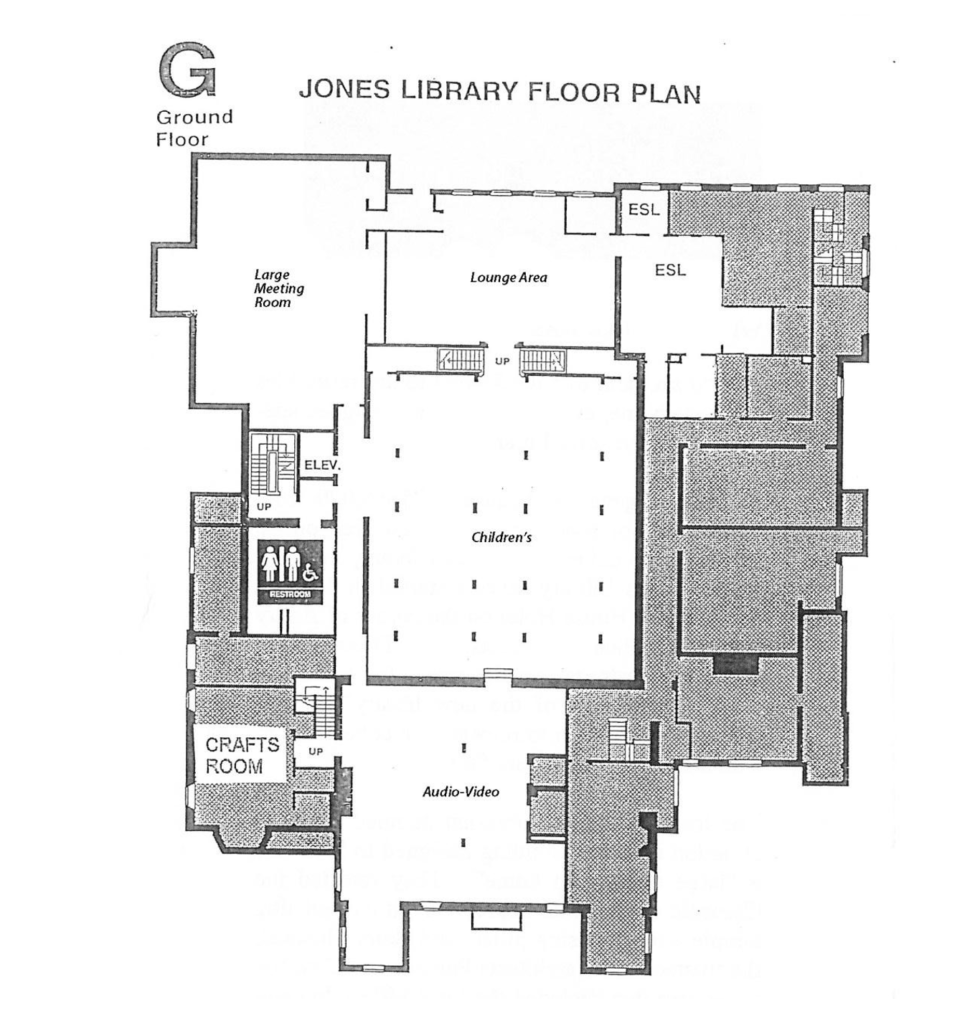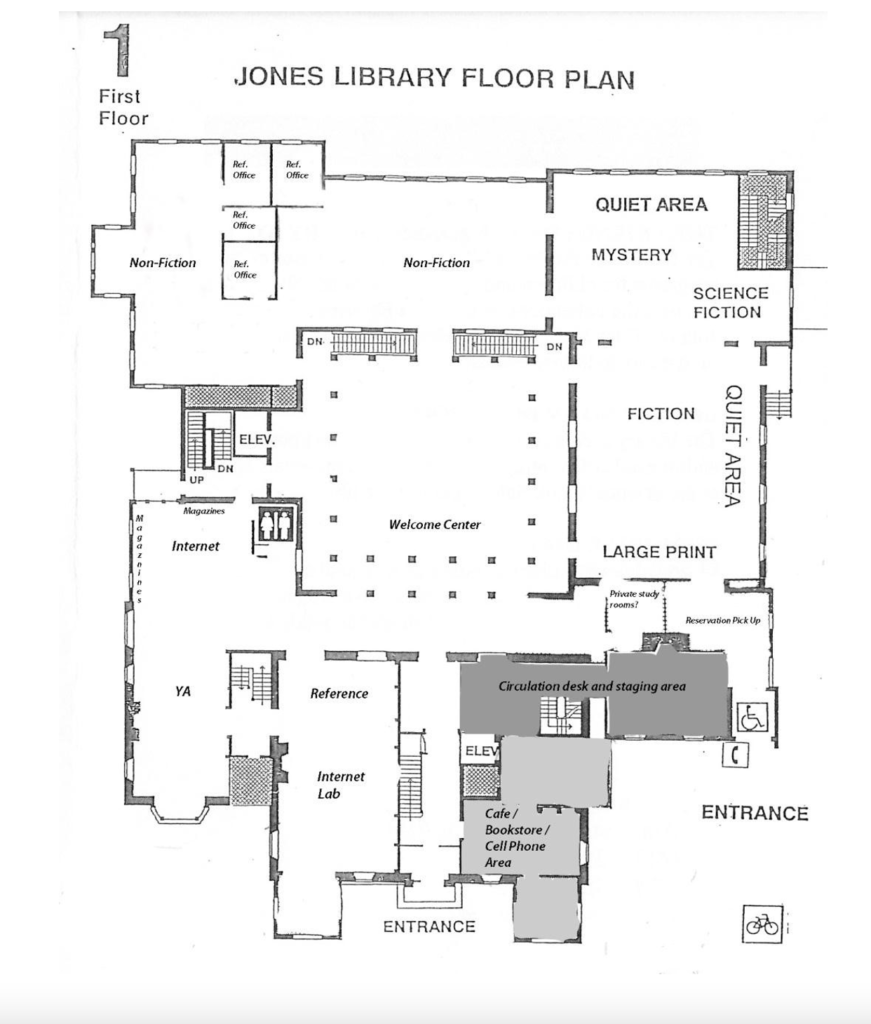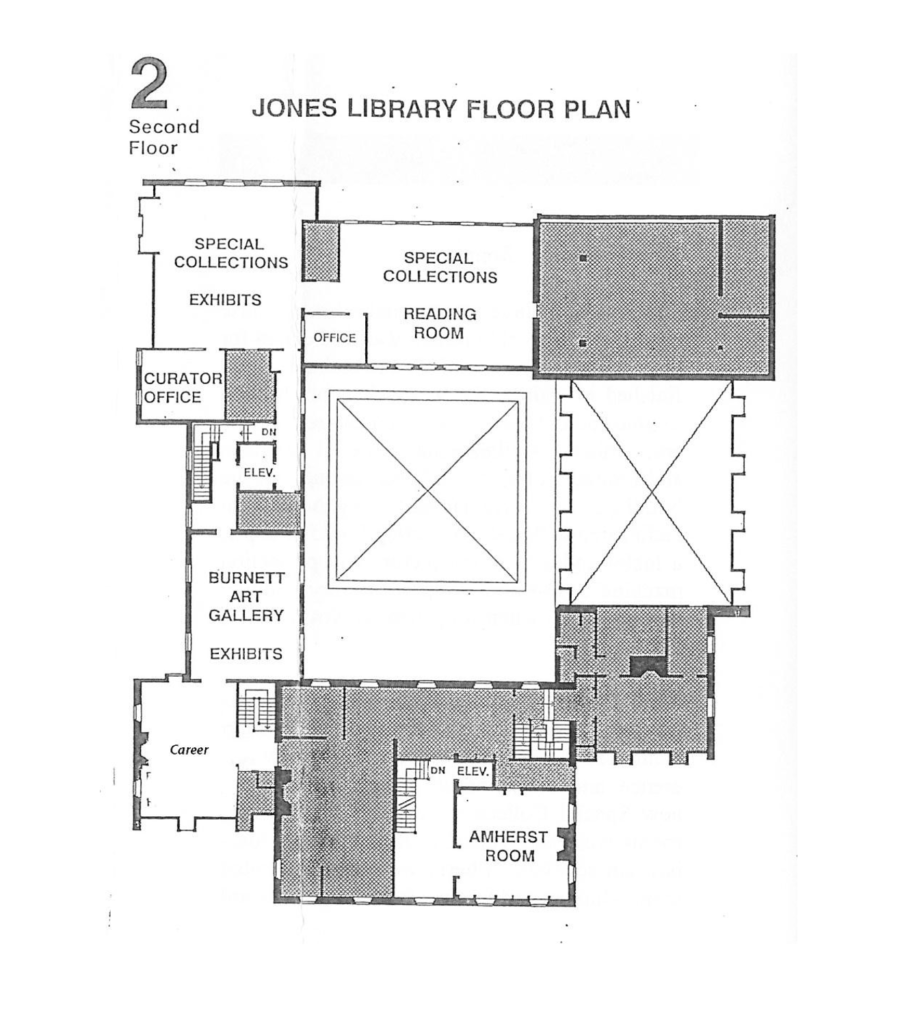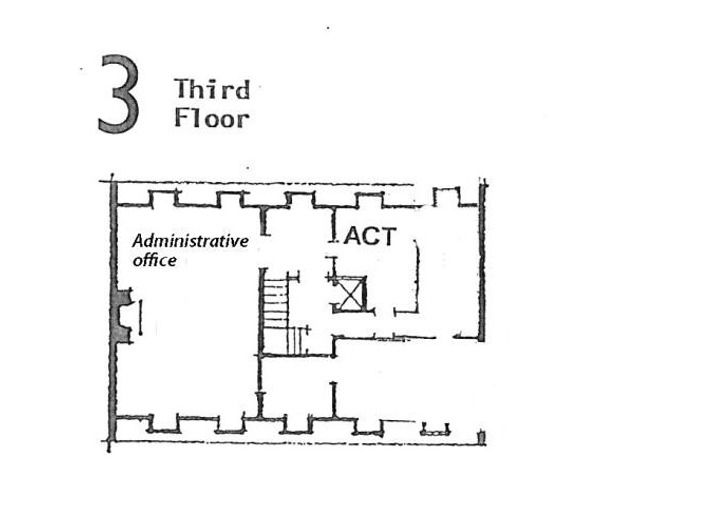Issues & Analyses: Popp Report Offers Affordable Alternative To Costly Jones Library Expansion

Photo: flckr.com. Creative Commons
Back in October, Jeff Lee reported on a professional space study requested by the Jones Library prior to development of the multimillion-dollar plan to expand the building by 15,000 sq. ft. The study reveals a number of recommendations for achieving programming goals within the existing library footprint.
The report, evidently heretofore unseen by the public, was prepared by Anna Popp, a consultant with Massachusetts Library System (MLS), a state-supported collaborative providing services to libraries across the Commonwealth. The document was obtained in response to a Public Record Request by The Amherst Indy after Trustee President Austin Sarat alluded to its existence at the September 12 Board meeting. An online search turned up no mention of the study on the Jones Library or Town of Amherst websites, nor in any trustee meeting minutes.
The Popp study recommends a combination of aggressive weeding of underutilized collections, low-cost space reassignments, repurposing some staff areas for public use, and researching options for storing Special Collections materials off-site.
To our knowledge, until now, the report has never been available to the public. We reproduce it below.
Lee’s original summary of the report can be found here.
Ken Rosenthal’s proposal to use the Popp Report as a Plan “B” should the burgeoning costs of the proposed expansion become untenable, can be found here.
Space Recommendations For Amherst Libraries Jones Library
by Anna Popp, Massachusetts Library System
Introduction
Thank you for asking the Massachusetts Library System for assistance with your space planning project. Please note that MLS Advisory services are offered without stipulation or expectations. Your organization and your staff are not required to implement all or any of the suggestions included herein. I can continue to assist you to interpret and adjust this plan to suit your unique needs. I appreciate the individual personality of each library in the Commonwealth and value the opportunity to maintain and define each library’s character.
I recommend that whatever space planning changes Jones decides on, you work to incorporate those goals in your Strategic Plan under the facilities section. In this way, the organization as a whole is directed to the common goal of redefining and repurposing the Jones site.
A Roadmap To Change
Because budgets, needs and opportunities are so uncertain, I advocate the Roadmap approach to rearranging and redesigning space. This approach begins by creating a Master Plan for the final product. From that Master Plan the Jones would identify stages which are defined by what is accomplished, not when. The stages exist independently of one another and can be implemented in any order. (For instance a relocation of a collection and a renovation & repurposing of the vacated space could be a stage.) You can then determine the resources needed to complete each stage and, by being flexible, tackle a stage when the necessary resources become available. I always recommend having a timeline in place, but the realities of life frequently interrupt the best laid plans.
Collection Assessment
The Amherst Jones collection is very large. The Jones must implement an aggressive weeding project if you wish to increase your available space. Overall, a reduction of over 64,000 items is in order. Because of the magnitude of this recommendation, I have devoted a good deal of this space plan to addressing the collection. This aspect alone is intimidating. That being said, the staff at the Jones should be very proud of the collections they have built. These collections boast an impressive circulation, and that accomplishment is not to be overlooked. However, weeding must happen. It is one of the most commonly overlooked fundamentals of librarianship. We librarians work so hard to build powerful, meaningful collections, it is admittedly difficult to undo our work.
In this report I will address targets for reduction in certain segments of your collection. I don’t make recommendations for how to choose the items to be discarded. For that, I defer to generally accepted library practices of reviewing items for use, age, format, condition and “ick” factor (yellowed, dirty or damaged).
For purposes of this collection assessment, I am relying upon the Wisconsin Public Library Standards, a nationally recognized benchmark for public library services and collections. In keeping with the practices of my colleagues at the MBLC, I use the data corresponding with the Basic level of service. If the Jones were to look to a large scale renovation in the future, the collection must be brought into line with the Basic Level of the Wisconsin Standards to meet MBLC funding requirements.
This assessment is based solely on the collection of the Jones Library, main branch. When assessing a library’s collection in terms of Wisconsin standards, all branches holdings should be considered. This point will be noted where appropriate. Further, the holdings of the Jones Special Collections were not considered because of the nature of the archival collection.
Service targets for Amherst Libraries Based on Municipal population of 37,800
| Wisconsin Standard | Jones | ||
| Volumes held (print) | 128,520 | 162,872 | +34,352 |
| Audio Recordings Held | 8,694 | 14,211 | +5,517 |
| Video Recordings Held | 8,694 | 7,165 | -1,529 |
| Collection size | 151,200 | 216,048 | +64,848 |
Amherst Jones needs to see a substantial reduction in collection size, in order to see the desired goal of increased space. 34,000 books represents between 600 and 1100 empty shelves. Those shelves represent space that can be organized and repurposed.
Data was aggregated to lump data reported across multiple locations, but representing similar I-types. Without a close familiarity of the Jones collection, I may have erroneously aggregated some data. Aggregated data was then plotted on charts comparing holdings (x axis) to circulation (y axis) (considered a turnover ratio). This offers a visual aid to understand the relationship between holdings and use in the Jones. I use this method because I believe that the trends which become evident vary from library to library, and that is part of each library’s character. We can see what the standard rollover of a collection is and quickly identify the segments which perform remarkably well or poorly. See the attached appendix for the data and charts used to assess this collection.
Print
Among large print collection groupings, Jones boasts Mystery and J Picture Hardcover collections which perform remarkably well. The Fiction and Juvenile Book collections also perform well. In the smaller groupings, the YA, Science Fiction and Paperback collections deserve recognition. The three most underperforming collections are nonfiction, juvenile nonfiction and magazines.
- The nonfiction collection has an impressive circulation, however, the size of the collection is an anomaly in the Jones collection. By far the largest collection, it is more than twice the size of the next smallest collection. I recommend a goal of eliminating 10,000 items from this collection.
- The juvenile nonfiction collection has moderate circulation, but not enough to justify the size. I recommend targeting 5,000 items for weeding.
- Wisconsin standards address the number of periodical titles that a library should hold, but they do not suggest holding periods. In a survey of MA libraries, our colleagues usually report holding the current year and one or two years back. In many cases, libraries favored an a la carte approach to holdings based on title. Based on performance, I recommend reducing periodical holdings from 17,000 to 7,000.
- Beyond these drastic steps, consider the changing face of reference collections.
The Jones reference collection should be reduced, perhaps by half.
- After large reductions are taken, I suggest that the collections be uniformly reduced to achieve the final print goal.
Audio & Video Collections
The Jones A/V collection is a major contributor to the circulation numbers. Strong performers should be fostered and new delivery models explored to maintain the collection’s contribution.
Audio
The J Book on CD collection performs strongly and should be developed.
- Curiously, the adult CD collection is underperforming for its size when taking into consideration the trend of the overall collection. I recommend a movement toward reducing the collection to 6,000 items, and reassessing the collection trend. Frequently reducing a collection’s size improves performance. The Jones CD collection is valued in the community. Improving the turnover rate of this collection should be a goal.
- I recommend exploring alternate delivery models in order to keep this respected collection accessible to an increasingly mobile user group.
- Predictably, the audio cassette and J Book on Tape collections are underperforming. I recommend an elimination of 300 and 400 items, respectively.
Video
The DVD and J DVD collections perform very strongly and should be grown.
Reflecting the use of the audio collection, the JVideo and Video collection are losing momentum. The collections should be reduced by 500 and 300 items, respectively.
Disclaimer
Please note, that reducing the Amherst Jones print collection to 151,200 items is not considered in keeping with Wisconsin standards, as stated earlier. All Amherst Libraries collections, in all branches, account for the total Amherst Libraries holdings.
Space Reassignments
As the Jones collection is refreshed, the conditions are perfect to redesign how space is used at the Jones. Currently, collections are well defined by space, which is an important quality not to be lost. However, collections and space needs change with each new generation of users. Current studies of library users show that users are looking for certain things in a library:
- Comfortable space to work, read and play o No one type of seating appeals to all individuals or works for all tasks.
Varied seating and working areas should be provided.
- Library users want space to be welcoming, allowing conversation, food and drink.
- Because of the unique holdings of the Jones, food and drink certainly cannot be permitted in all areas. But the architecture of the Jones lends itself to designated areas for silence, conversation, cellphones or refreshments.
- Technology should be current.
- Consider expanding laptop, tablet and gadget loaning (on site) to augment your internet options for users.
Changes suggested here will require elements of contract work, either to restructure entry ways, provide electricity or to facilitate wiring.
Efforts should be made to coordinate storage needs and space. There are so many interesting areas in the Jones, and each department seems to have carved out its own storage spaces. While it makes sense to have storage near offices, centralized storage would be more efficient and economical.
Office space will need to be recovered from various underused areas of the building.
Further, the Trustees could consider recovering some of these interesting spaces and renting secure space to scholars, writers and the like, which fits the community profile.
Staff Requests
Jones staff had constructive and valuable contributions to be considered. Not all requests or suggestions could be honored in these recommendations.
I understand that staff value a clean, well lit and attractive work space. However, some of the “prime real estate” in the Jones is currently limited to staff areas. This is space that is not available to the patrons, the people for whom the building was erected. I have attempted to make these areas available to users and find alternate attractive and functional areas for staff.
In these recommendations, I have tried to accommodate enough flexibility for self – check kiosks and related self-services to be offered, should Amherst Libraries choose to follow that path.
I was unable to place the Circulation and Reference staff in immediate proximity of each other. I felt this was a goal that could be sacrificed simply because there are many options for internal communications systems (pagers, talkies, etc.) and I advocate for service staff to be moving about the building whenever possible, ready to assist patrons on point. The repositioning of the Circ Desk serves a few purposes. First, it positions staff a bit closer to the door, making that long entryway seem a bit briefer. Secondly, the positioning adjacent to the outer courtyard offers an option to create separate drop off and check out areas, which Circ staff requested. If more space is required by circulation staff, the office and bathroom adjacent to the proposed location could be annexed. I didn’t include this as a formal recommendation because of the low-light and quaintness of the space. I judged that the space wouldn’t be valued by staff and it was judged better suited to public use.
The space needs of the special collection pose a challenge to address. There is no available space adjoining the climate controlled storage. Off-site storage options should be researched.
Ground Floor

- Magazines, Career Center and non-fiction are relocated Lounge area or storytime space established.
- Children’s collection centralized
- AV area relocated. All AV material for all collections, age groups, demographics, etc. are centralized in one location. There is a possible need for construction to create office space.
First Floor

- Repurpose offices and information area. Create bookstore, cellphone, café lounge area. The space currently serving as the Director’s office could be repurposed as the shop area, allowing it to be secured when not staffed, but leaving the lounging areas available to the public.
- Shift Circulation Desk toward the entry. Take over foyer space and current cell phone area. The public water cooler will need to be relocated. Move the staging area for easy access to the entrance. Some construction will be required.
- Redirect handicap entrance to join Large Print collection. Integrate a self-service holds pick-up location.
- Previous staff areas can possibly be repurposed to make a few small group meeting spaces.
- The area currently dedicated to Children’s becomes rededicated to multiple applications: YA, Internet and the magazine and reference collections. This is overseen by Reference staff.
- What is currently AV offices are rededicated to Reference staff offices for their off-desk duties. In some cases, offices may house multiple desks. Reference staff on desk duty will have oversight of the YA area, as well as the computer support.
- The internet options for the public will be spread among two locations in close enough proximity to be networked to the same public printers and equipment, but distinct enough that one grouping can be arranged and used in a lab setting for instruction, if desired. Comfortable and varied seating will encourage those with their own laptops to also use this area.
- Non-fiction is moved the current AV and Reference areas, bringing the adult print materials to one location.
- The YA area is in the hub of the activity, just where teens want to be, but with the required modicum of privacy. A set of stairs leads them directly down to the AV collection or up to staff areas.
- The courtyard can be set up with a small welcome station. Low shelving set at 45° angles can feature new or noteworthy materials. (Collections from the ground floor and second floor should feature prominently in order to not be overlooked by patrons.) The low shelving keeps the line of sight open. Because of the beauty of the area, seating areas should also be incorporated.
Second Floor

The Children’s collection is removed and the Career Center is relocated to the second floor.
Third Floor

- With permission, repurpose the Trustees Room to the Director’s office, with meeting room.
- Possible recapture of other areas for other staff or multipurpose (provided elevator access is available).
